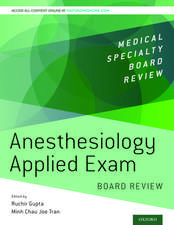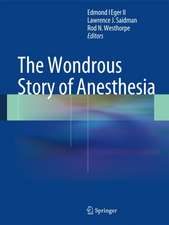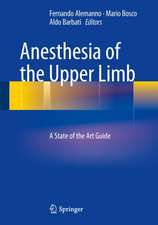Neuroanesthesia and Cerebrospinal Protection
Editat de Hiroyuki Uchino, Kazuo Ushijima, Yukio Ikeda Contribuţii de Jeremy Williams, Edward F. Barrogaen Limba Engleză Hardback – 22 aug 2015
The main purpose of neuroanesthesia/neurocritical care is to deliver cerebrospinal protection in neurosurgical and cardiovascular surgeries. How should we select the best anesthetic management to prevent neurological complications for patients who, for instance, undergo different types of surgery for subarachnoid hemorrhage, stroke, head trauma, carotid endarterectomy, or cardiovascular surgery under cardiopulmonary bypass? These pathological conditions include the risk of transient cerebrospinal ischemia, and if our management is not precise, it may induce serious neurological sequelae. Although there is an urgent need to establish the treatment and elucidate the molecular mechanisms of cerebrospinal injury, many components are intertwined, making this a challenge we have not completely solved yet.
This volume makes the management of neuroanesthesia more accessible not only for primary residents but also for specialists, providing a valuable resource on the current perspectives of neuroanesthesia.
| Toate formatele și edițiile | Preț | Express |
|---|---|---|
| Paperback (1) | 815.61 lei 38-44 zile | |
| Springer – 23 oct 2016 | 815.61 lei 38-44 zile | |
| Hardback (1) | 1329.06 lei 3-5 săpt. | |
| Springer – 22 aug 2015 | 1329.06 lei 3-5 săpt. |
Preț: 1329.06 lei
Preț vechi: 1399.01 lei
-5% Nou
Puncte Express: 1994
Preț estimativ în valută:
254.38€ • 262.15$ • 214.76£
254.38€ • 262.15$ • 214.76£
Carte disponibilă
Livrare economică 11-25 februarie
Preluare comenzi: 021 569.72.76
Specificații
ISBN-13: 9784431544890
ISBN-10: 4431544895
Pagini: 300
Ilustrații: XIV, 725 p. 145 illus., 61 illus. in color.
Dimensiuni: 155 x 235 x 45 mm
Greutate: 1.55 kg
Ediția:1st ed. 2015
Editura: Springer
Colecția Springer
Locul publicării:Tokyo, Japan
ISBN-10: 4431544895
Pagini: 300
Ilustrații: XIV, 725 p. 145 illus., 61 illus. in color.
Dimensiuni: 155 x 235 x 45 mm
Greutate: 1.55 kg
Ediția:1st ed. 2015
Editura: Springer
Colecția Springer
Locul publicării:Tokyo, Japan
Public țintă
Professional/practitionerCuprins
Part I General Consideration : Neuroanatomy for Neuroanesthesia.-
Chapter 1 Anatomy of Adult Central Nervous System: structure and Function of the Brain and Spinal cord.-
Part II General Consideration : Neurophysiology for Neuroanesthesia.-
Chapter 2 Cerebrospinal Blood Flow and its Regulation.-
Chapter 3 The Neuroendocrine System and its Regulation.-
Chapter 4 Molecular Mechanisms of Brain Ischemia and Its Protection.-
Chapter 5 Molecular Mechanism of Ischemic Damage to the Spinal Cord and Protection Against.-
Chapter 6 Mitochondrial Physiology and Cerebrospinal Protection.-
Chapter 7 Stem Cells: How We Could Restore the Brain Function After Ischemic Damage.-
Part III General Consideration : Neuropharmacology for Neuroanesthesia.-
Chapter 8 Volatile Anesthetics and Neuroprotection.-
Chapter 9 Intravenous Anesthetics and Neuroprotection.-
Chapter 10 Opioids and Adjuvant Drugs.-
Chapter 11 Steroids, Diuretics and Anticonvulsants.-
Chapter 12 Neuroprotective Drugs.-
Chapter 13 Neurotoxicity of Anesthetic Agents for Developing and Adult Brain.-
Part IV General Consideration : Monitoring in Neuroanesthesia.-
Chapter 14 Role of Electroencephalography for Cerebral Functions in Neuroanesthesia.-
Chapter 15 Role and Management of Intracranial Pressure in Neuroanesthesia.-
Chapter 16 Role of Jugular Venous Oxygen Saturation in Neuroanesthesia.-
Chapter 17 Role of Microdialysis in Neuroanesthesia.-
Chapter 18 Role of Evoked Potentials in Neuroanesthesia.-
Chapter 19 Role of Transcranial Doppler Ultrasonography in Neuroanesthesia.-
Chapter 20 Role of Near-Infrared Spectroscopy in Neuroanesthesia.-
Chapter 21 Role of Pressure Reactivity Index in Neurocritical Care.-
Part V Anesthetic management : Specific Issue for Neuroanesthesia.-
Chapter 22 Preoperative Assessment.-
Chapter 23 Neurosurgical Technique and Approach.-
Chapter 24 The Management of Intracranial Pressure and Cerebral Edema.-
Chapter 25 Basics of Required Neuroimaging for Neuroanesthesia.-
Chapter 26 Positioning of Neurosurgical Patients.-
Chapter 27 Fluid Management.-
Part VI Anesthetic management : Vascular Procedures.-
Chapter 28 Anesthesia for Intracranial Vascular Surgery.-
Chapter 29 Anesthesia for Carotid Endarterectomy.-
Chapter 30 Anesthesia for Adult Brain Arteriovenous Malformations and Moyamoya Disease.-
Part VII Anesthetic Management : Neuroanesthesia for Tumor Surgery.-
Chapter 31 Anesthesia for Posterior Fossa Tumor Surgery.-
Chapter 32 Anesthesia for Supratentorial Tumor Surgery
Chapter 33 Anesthesia in Awake Craniotomy.-
Part VIII Anesthetic Management : Neuroanesthesia for Traumatic Brain and Spinal Injury.-
Chapter 34 Anesthetic Management of Severe Head Injury.-
Chapter 35 Anesthetic Management of Spinal Cord Injury (Unstable Cervical Spine).-
Part IX Anesthetic Management : Specific Situation in Neuroanesthesia.-
Chapter 36 Anesthesia for Spinal Surgery.-
Chapter 37 Anesthesia for Epilepsy Surgery.-
Chapter 38 Anesthesia for Pituitary Surgery.-
Chapter 39 Anesthesia for Interventional Radiology.-
Chapter 40 Neuromodulation: Deep Brain Stimulation.-
Chapter 41 Anesthesia for Stereotaxic Neurosurgery and Deep Brain Stimulation.-
Chapter 42 Anesthetic Management of Pregnant Women with Stroke.-
Chapter 43 Anesthesia for Patients with Neuromuscular Disease.-
Chapter 44 Management for Massive Hemorrhage during Surgery.-
Part X Anesthetic Management : Neuroanesthesia for Pediatric Surgery.-
Chapter 45 Anesthesia for Pediatric Tumor Surgery.-
Chapter 46 Anesthesia during Surgery for Pediatric Traumatic Brain Injury.-
Chapter 47 Anesthesia during Surgery for Meningomyelocele.-
Chapter 48 Anesthesia during Surgery for Vascular Anomalies.-
Chapter 49 Anesthesia for Pediatric Cardiac Surgery and Brain Protection.-
Chapter 50 Anesthesia for Diagnostic and Perioperative MRI.-
Part XI Anesthetic Management : Cardiovascular Surgery and Cerebrospinal Protection.-
Chapter 51 Cardiovascular Surgical Technique under Cardiopulmonary Bypass and Cerebrospinal Protection.-
Chapter 52 Brain Protection and Anesthetic Management during Cardiac Surgery.-
Chapter 53 Anesthesia for Adult Vascular Surgery and Cerebrospinal Protection.-
Chapter 54 Postoperative Cognitive Dysfunction after Cardiac Surgery and Neuroprotection.-
Chapter 55 Postoperative Cognitive Dysfunction after Noncardiac Surgery and Neuroprotection.-
Part XII Complications and Other Considerations.-
Chapter 56 Electrolyte Disorders.-
Chapter 57 Crisis Management for Perioperative Complications (Seizure, Hemorrhage, Neurogenic Pulmonary Edema and Venous Embolism).-
Chapter 58 Pain Management in Neuroanesthesia.-
Chapter 59 Hypothermia for Brain Protection.-
Chapter 60 PCPS for Brain Resuscitation Extracorporeal Cardiopulmonary Resuscitation (ECPR).-
Chapter 61 Brain Death and Organ Donation.
Chapter 1 Anatomy of Adult Central Nervous System: structure and Function of the Brain and Spinal cord.-
Part II General Consideration : Neurophysiology for Neuroanesthesia.-
Chapter 2 Cerebrospinal Blood Flow and its Regulation.-
Chapter 3 The Neuroendocrine System and its Regulation.-
Chapter 4 Molecular Mechanisms of Brain Ischemia and Its Protection.-
Chapter 5 Molecular Mechanism of Ischemic Damage to the Spinal Cord and Protection Against.-
Chapter 6 Mitochondrial Physiology and Cerebrospinal Protection.-
Chapter 7 Stem Cells: How We Could Restore the Brain Function After Ischemic Damage.-
Part III General Consideration : Neuropharmacology for Neuroanesthesia.-
Chapter 8 Volatile Anesthetics and Neuroprotection.-
Chapter 9 Intravenous Anesthetics and Neuroprotection.-
Chapter 10 Opioids and Adjuvant Drugs.-
Chapter 11 Steroids, Diuretics and Anticonvulsants.-
Chapter 12 Neuroprotective Drugs.-
Chapter 13 Neurotoxicity of Anesthetic Agents for Developing and Adult Brain.-
Part IV General Consideration : Monitoring in Neuroanesthesia.-
Chapter 14 Role of Electroencephalography for Cerebral Functions in Neuroanesthesia.-
Chapter 15 Role and Management of Intracranial Pressure in Neuroanesthesia.-
Chapter 16 Role of Jugular Venous Oxygen Saturation in Neuroanesthesia.-
Chapter 17 Role of Microdialysis in Neuroanesthesia.-
Chapter 18 Role of Evoked Potentials in Neuroanesthesia.-
Chapter 19 Role of Transcranial Doppler Ultrasonography in Neuroanesthesia.-
Chapter 20 Role of Near-Infrared Spectroscopy in Neuroanesthesia.-
Chapter 21 Role of Pressure Reactivity Index in Neurocritical Care.-
Part V Anesthetic management : Specific Issue for Neuroanesthesia.-
Chapter 22 Preoperative Assessment.-
Chapter 23 Neurosurgical Technique and Approach.-
Chapter 24 The Management of Intracranial Pressure and Cerebral Edema.-
Chapter 25 Basics of Required Neuroimaging for Neuroanesthesia.-
Chapter 26 Positioning of Neurosurgical Patients.-
Chapter 27 Fluid Management.-
Part VI Anesthetic management : Vascular Procedures.-
Chapter 28 Anesthesia for Intracranial Vascular Surgery.-
Chapter 29 Anesthesia for Carotid Endarterectomy.-
Chapter 30 Anesthesia for Adult Brain Arteriovenous Malformations and Moyamoya Disease.-
Part VII Anesthetic Management : Neuroanesthesia for Tumor Surgery.-
Chapter 31 Anesthesia for Posterior Fossa Tumor Surgery.-
Chapter 32 Anesthesia for Supratentorial Tumor Surgery
Chapter 33 Anesthesia in Awake Craniotomy.-
Part VIII Anesthetic Management : Neuroanesthesia for Traumatic Brain and Spinal Injury.-
Chapter 34 Anesthetic Management of Severe Head Injury.-
Chapter 35 Anesthetic Management of Spinal Cord Injury (Unstable Cervical Spine).-
Part IX Anesthetic Management : Specific Situation in Neuroanesthesia.-
Chapter 36 Anesthesia for Spinal Surgery.-
Chapter 37 Anesthesia for Epilepsy Surgery.-
Chapter 38 Anesthesia for Pituitary Surgery.-
Chapter 39 Anesthesia for Interventional Radiology.-
Chapter 40 Neuromodulation: Deep Brain Stimulation.-
Chapter 41 Anesthesia for Stereotaxic Neurosurgery and Deep Brain Stimulation.-
Chapter 42 Anesthetic Management of Pregnant Women with Stroke.-
Chapter 43 Anesthesia for Patients with Neuromuscular Disease.-
Chapter 44 Management for Massive Hemorrhage during Surgery.-
Part X Anesthetic Management : Neuroanesthesia for Pediatric Surgery.-
Chapter 45 Anesthesia for Pediatric Tumor Surgery.-
Chapter 46 Anesthesia during Surgery for Pediatric Traumatic Brain Injury.-
Chapter 47 Anesthesia during Surgery for Meningomyelocele.-
Chapter 48 Anesthesia during Surgery for Vascular Anomalies.-
Chapter 49 Anesthesia for Pediatric Cardiac Surgery and Brain Protection.-
Chapter 50 Anesthesia for Diagnostic and Perioperative MRI.-
Part XI Anesthetic Management : Cardiovascular Surgery and Cerebrospinal Protection.-
Chapter 51 Cardiovascular Surgical Technique under Cardiopulmonary Bypass and Cerebrospinal Protection.-
Chapter 52 Brain Protection and Anesthetic Management during Cardiac Surgery.-
Chapter 53 Anesthesia for Adult Vascular Surgery and Cerebrospinal Protection.-
Chapter 54 Postoperative Cognitive Dysfunction after Cardiac Surgery and Neuroprotection.-
Chapter 55 Postoperative Cognitive Dysfunction after Noncardiac Surgery and Neuroprotection.-
Part XII Complications and Other Considerations.-
Chapter 56 Electrolyte Disorders.-
Chapter 57 Crisis Management for Perioperative Complications (Seizure, Hemorrhage, Neurogenic Pulmonary Edema and Venous Embolism).-
Chapter 58 Pain Management in Neuroanesthesia.-
Chapter 59 Hypothermia for Brain Protection.-
Chapter 60 PCPS for Brain Resuscitation Extracorporeal Cardiopulmonary Resuscitation (ECPR).-
Chapter 61 Brain Death and Organ Donation.
Recenzii
“The textbook from Uchino and colleagues, Neuroanesthesia and Cerebrospinal Protection, is an effort to amalgamate the complex nature of the processes involved in a neurosurgical patient. … this book is a reasonable attempt at a current evidence-based textbook in neuroanesthesia directed toward residents and junior faculty alike. … there is a considerable emphasis on local Japanese content, the perspectives it brings make it a valuable addition to any departmental library.” (Nitin Ahuja, Canadian Journal of Anesthesia, Vol. 64, 2017)
“Neuroanesthesia and Cerebrospinal Protection may serve as a broad overview for academicians, anesthesiology trainees, and all practitioners who regularly or less often encounter patients with neuronal injury and/or with high risk of that in neuro, cardiac, and vascular anesthesiology. Certainly, the book will find its place on the book shelves because such a starting point is indispensable to stimulate more widespread search for in-depth review of current literature on knowledge and research in central nervous system protection.” (Sabine Himmelseher and Eberhard F. Kochs, Anesthesia & Analgesia, Vol. 123 (4), October, 2016)
“This overview of neuroanesthesia covers both basic science and clinical aspects. … The intended audience is in-training and postgraduate neuroanesthesiologists, and the book is written to suit everyone’s needs. … This book is very well written. … It’s easy on the eye and captivating, making reading it very pleasurable.” (Tariq M. Malik, Doody’s Book Reviews, November, 2015)
“Neuroanesthesia and Cerebrospinal Protection may serve as a broad overview for academicians, anesthesiology trainees, and all practitioners who regularly or less often encounter patients with neuronal injury and/or with high risk of that in neuro, cardiac, and vascular anesthesiology. Certainly, the book will find its place on the book shelves because such a starting point is indispensable to stimulate more widespread search for in-depth review of current literature on knowledge and research in central nervous system protection.” (Sabine Himmelseher and Eberhard F. Kochs, Anesthesia & Analgesia, Vol. 123 (4), October, 2016)
“This overview of neuroanesthesia covers both basic science and clinical aspects. … The intended audience is in-training and postgraduate neuroanesthesiologists, and the book is written to suit everyone’s needs. … This book is very well written. … It’s easy on the eye and captivating, making reading it very pleasurable.” (Tariq M. Malik, Doody’s Book Reviews, November, 2015)
Textul de pe ultima copertă
This book is a knowledge-based text that covers the anatomy, neurophysiology, and neuropharmacology needed to carry out the necessary management and cerebrospinal protection during neuroanesthesia. Especially to make the subject of neuroanesthesia more approachable, we introduce surgical measures utilized in neurosurgery, cardiovascular surgery, neuromodulation, and related procedures.
The main purpose of neuroanesthesia/neurocritical care is to deliver cerebrospinal protection in neurosurgical and cardiovascular surgeries. How should we select the best anesthetic management to prevent neurological complications for patients who, for instance, undergo different types of surgery for subarachnoid hemorrhage, stroke, head trauma, carotid endarterectomy, or cardiovascular surgery under cardiopulmonary bypass? These pathological conditions include the risk of transient cerebrospinal ischemia, and if our management is not precise, it may induce serious neurological sequelae. Although there is an urgent need to establish the treatment and elucidate the molecular mechanisms of cerebrospinal injury, many components are intertwined, making this a challenge we have not completely solved yet.
This volume makes the management of neuroanesthesia more accessible not only for primary residents but also for specialists, providing a valuable resource on the current perspectives of neuroanesthesia.
The main purpose of neuroanesthesia/neurocritical care is to deliver cerebrospinal protection in neurosurgical and cardiovascular surgeries. How should we select the best anesthetic management to prevent neurological complications for patients who, for instance, undergo different types of surgery for subarachnoid hemorrhage, stroke, head trauma, carotid endarterectomy, or cardiovascular surgery under cardiopulmonary bypass? These pathological conditions include the risk of transient cerebrospinal ischemia, and if our management is not precise, it may induce serious neurological sequelae. Although there is an urgent need to establish the treatment and elucidate the molecular mechanisms of cerebrospinal injury, many components are intertwined, making this a challenge we have not completely solved yet.
This volume makes the management of neuroanesthesia more accessible not only for primary residents but also for specialists, providing a valuable resource on the current perspectives of neuroanesthesia.
Caracteristici
Covers the latest trends in all aspects of neuroanesthesia Addresses the brain and spinal injuries associated with cardiovascular anesthesia Written for both junior residents and senior doctors interested in anesthesiology


























